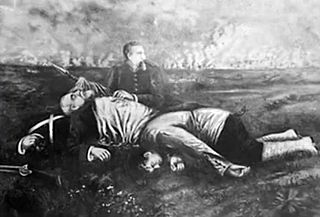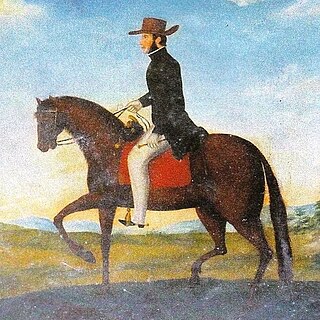
The Football War, also known as the Soccer War or the 100 Hour War, was a brief military conflict fought between El Salvador and Honduras in 1969. Existing tensions between the two countries coincided with rioting during a 1970 FIFA World Cup qualifier. The war began on 14 July 1969 when the Salvadoran military launched an attack against Honduras. The Organization of American States (OAS) negotiated a cease-fire on the night of 18 July, hence its nickname. Salvadoran troops were withdrawn in early August.

The Federal Republic of Central America, initially known as the United Provinces of Central America, was a sovereign state in Central America that existed between 1823 and 1839/1841. The republic was composed of five states, and a Federal District from 1835 to 1839. Guatemala City was its capital city until 1834, when the seat of government was relocated to San Salvador. The Federal Republic of Central America was bordered on the north by Mexico, on the south by Gran Colombia and on its eastern coastline by the Mosquito Coast and British Honduras, both claimed by the federal republic.

José Francisco Morazán Quesada was a liberal Central American politician and general who served as president of the Federal Republic of Central America from 1830 to 1839. Before he was president of Central America he was the head of state of Honduras. He rose to prominence at the Battle of La Trinidad on November 11, 1827. Morazán then dominated the political and military scene of Central America until his execution in 1842.
Silvestre Selva Sacasa was a Nicaraguan politician of Basque origin, who, as a senator in the State Legislative Assembly, was appointed by the invading forces of Francisco Malespín to serve as provisional Supreme Director, served from 16 December 1844 to 20 January 1845 with headquarters in the city of Masaya.

Francisco Malespín Herrera was a Salvadoran military officer and politician, elected as the president of El Salvador in 1844. He served from 7 February 1844 to 15 February 1845, when he was deposed by his vice president Joaquín Eufrasio Guzmán after invading and overthrowing the liberal government in Nicaraguan. He also led El Salvador to a short unsuccessful war against Guatemala. After being deposed, Malespin returned to El Salvador with forces from Honduras, but he was captured and assassinated. Some of Malespin's closest allies were Francisco Ferrera in Honduras as well as Juan Lindo, both conservatives. He was supported by Honduras after his downfall.

Eugenio Aguilar González was a Salvadoran politician who served as president of El Salvador from 1846 to 1848. He also served as the mayor of San Salvador in 1839 and 1864, and the president of the Legislative Assembly in 1849.

José Gerardo Barrios Espinoza was a Salvadoran military officer and politician who served as president of El Salvador on three occasions between June 1858 and his overthrow in October 1863.

Fernando Figueroa was the President of El Salvador from 14 May to 18 June 1885 and again from 1 March 1907 to 1 March 1911. He also served twice as Minister of National Defense and Governor of San Vicente.
The Battle of La Arada was fought on 2 February 1851 near the town of Chiquimula in Guatemala, between the forces of Guatemala and an Allied army from Honduras and El Salvador. As the most serious threat to Guatemala's liberty and sovereignty as a republic, it was the most important military victory in the country's history as an independent state.

Vicente Cerna y Cerna was president of Guatemala from 24 May 1865 to 29 June 1871. Loyal friend and comrade of Rafael Carrera, was appointed army's Field Marshal after Carraera's victory against Salvadorian leader Gerardo Barrios in 1863. He was appointed Carrera's successor after the caudillo's death in 1865 even though Guatemalan leaders would have preferred Field Marshal José Víctor Zavala.

The First Central American Civil War was a civil political and military conflict within the Federal Republic of Central America which lasted from 1827 until 1829. The civil war was fought between Liberal and Conservative lines with Francisco Morazán leading the Liberals and Manuel José Arce, a former Liberal, leading the Conservatives.

Barrios' War of Reunification, also known as Barrios' great attempt, was a war initiated by Guatemalan President Justo Rufino Barrios in 1885 with the goal of reunifying Central America. Of the five Central American countries, only Honduras supported Barrios' reunification effort; Costa Rica, El Salvador, and Nicaragua opposed it, as did Mexico.
The War of 1863 was a conflict fought between El Salvador and Guatemala from 13 February 1863 to 26 October 1863.

Malespín's War was a Salvadoran and Honduran invasion of Nicaragua caused by the election of liberal democrat Manuel Pérez at the time of Central American turmoil dictated by Rafael Carrera's conservative dictatorship in Guatemala.

The Salvadoran Campaign of 1832 or the Salvadoran Rebellion of 1832 was a military conflict in El Salvador in 1832.

The Second Central American Civil War or the Second Central American Federal War was a military conflict in Central America between 1838 and 1840.

The First Honduran-Salvadoran War was a military conflict between El Salvador and Honduras in 1845.
The Honduran-Guatemalan War (1853–1855) was a military conflict between the republics of Honduras and Guatemala sparked by the election of José Trinidad Cabañas, which opposed to the conservative ideologies of the guatemalan president, Rafael Carrera.
The Honduran-Salvadoran War of 1871 was a military conflict between El Salvador and Honduras in 1871.
The first Guatemalan–Salvadoran intervention in Honduras was a military conflict between the allied forces of Guatemala and El Salvador against Honduras in 1872.













